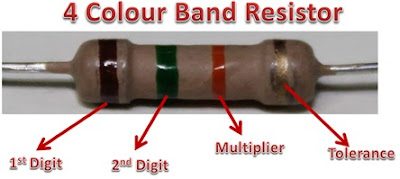How to calculate through-hole resistors value?
In Electronics, resistors play a vital role
in any circuit.
Lot of resistances is used in a big
circuit. Before using the resistor we should be aware of calculation of their
values and tolerance.
So in this post, I am going to teach you
how to calculate the value of resistors.
I will take example of through-hole
resistors having color band over their body.
First one is Brown.
Second one is Green.
Third one is Orange.
And
Fourth one, at the most right place, is Gold.
Its value is 15 Kohm with tolerance 5%.
Tolerance means its value can be between
14.25 and 15.75 Kohm.
Digit Value:
There is a Value chart for each colour
according to their position.
Value of black colour for 1st digit
is Nil.
Value of black colour for 1st, 2nd
and 3rd digit is 0.
Value of Brown colour for 1st, 2nd
and 3rd digit is 1.
Value of Red colour for 1st, 2nd
and 3rd digit is 2.
Value of Orange colour for 1st,
2nd and 3rd digit is 3.
Value of Yellow colour for 1st,
2nd and 3rd digit is 4.
Value of Green colour for 1st, 2nd
and 3rd digit is 5.
Value of Blue colour for 1st, 2nd
and 3rd digit is 6.
Value of Violet colour for 1st,
2nd and 3rd digit is 7.
Value of Gray colour for 1st, 2nd
and 3rd digit is 8.
Value of White colour for 1st, 2nd
and 3rd digit is 9.
Value of Gold colour for 1st, 2nd
and 3rd digit is Nil.
Value of Silver colour for 1st,
2nd and 3rd digit is Nil.
Multiplier:
Value of Black colour for Multiplier is 1.
Value of Brown colour for Multiplier is 10.
Value of Red colour for Multiplier is 100.
Value of Orange colour for Multiplier is 1000.
Value of Yellow colour for Multiplier is 10000.
Value of Green colour for Multiplier is 100000.
Value of Blue colour for Multiplier is 1000000.
Value of Violet colour for Multiplier is 10000000.
Value of Grey colour for Multiplier is 100000000.
Value of White colour for Multiplier is 1000000000.
Value of Gold colour for Multiplier is 0.1.
Value of Silver colour for Multiplier is 0.01.
Tolerance:
Value of Black colour for tolerance is Nil.
Value of Brown colour for tolerance is ±1%.
Value of Red colour for tolerance is ±2%.
Value of Orange colour for tolerance is ±3%.
Value of Yellow colour for tolerance is ±4%.
Value of Green colour for tolerance is ±0.5%.
Value of Blue colour for tolerance is ±0.25%.
Value of Violet colour for tolerance is ±0.10%.
Value of Grey colour for tolerance is ±0.05%.
Value of White colour for tolerance is Nil.
Value of Gold colour for tolerance is ±5%.
Value of Silver colour for tolerance is ±10%.
So about our resistor.
First colour is Brown means 1.
Second colour is Green means 5.
Third is multiplier, color is Orange mean 1000.
Now put all these values together.
15 x 1000 Ohm
15000 Ohm
15 Kohm.
Tolerance is ±5%, since Gold for tolerance
is ±5%.
Now you collect the resistors from around
you and try to find out the value of those resistors. Or you can imagine the
colour band of resistors.


Comments
Post a Comment